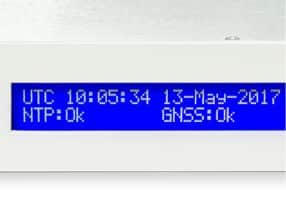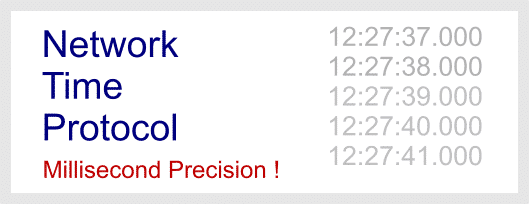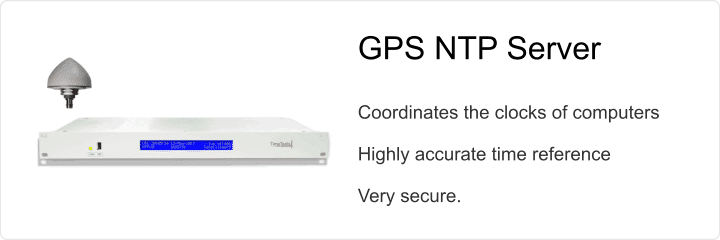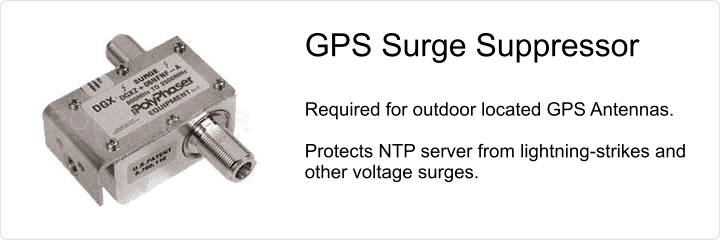
A GPS NTP Server is a computer device that obtains very accurate time from the GPS satellite system in order to precisely synchronize the clocks of computers over a network.
- Receives highly accurate time from the GPS system.
- Utilizes the Network Time Protocol (NTP).
- Coordinates the clocks of computers on a network.
- Much more accurate and secure than internet NTP servers.
- Communicates using the User Datagram Protocol (UDP), port 123.
- Coordinates computer clocks to within a few milliseconds of UTC.
The Network Time Protocol (NTP) is used to transfer time to servers, workstations and network devices, such as routers and switches.
Any hardware device that utilizes NTP or SNTP can be synchronized.
Many other network devices, such as CCTV cameras, digital video recorders (DVR) and telephone systems can also often be configured to coordinate their clocks using NTP.
Why are GPS NTP Servers and Computer Clock Synchronization Important?
Computers have real-time clocks to provide the current time to running applications. They use low-cost crystal oscillators, identical to the components found in every-day clocks and watches.
Like clocks and watches, a computers time drifts, often by significant amounts. A collection of computers initially synchronized to the same time, will have significantly differing times after a relatively short period of time.
Computers clocks need to be synchronized, so that events occur in an organized, predetermined manner.
For many organizations, such as financial institutions, media companies, security and military, computer clock synchronization is crucial. Applications such as data-logging, monitoring and control all rely on accurate time to function properly.
GPS NTP Time Server Applications
Precise time is critical to many applications and activities. Transaction processing, financial trading, data logging, machine monitoring and many other applications all rely on time synchronization. The availability of free-to-air atomic time has led to huge cost savings for companies and applications that rely on precise time. Lower cost hardware has also led to new and innovative applications.
Power companies are placing GPS NTP time servers in power plants and substations. This allows them to locate a power line break by analyzing the exact time of a fault as it propagates through the electrical grid.
Instrumentation often relies on accurate time. Equipment that may be located very far apart may require synchronization in order to act on or monitor linked events. For example, weather stations located in different parts of a country require synchronized instrumentation in order to accurate track weather systems.
Large institutions providing financial services and trading use GPS to very precisely time-stamp transactions. This provides a traceable record of the order of events as they occurred.
GPS Time Server Hardware
Equipment can receive GPS time and positioning information by using an antenna and receiver. The receiver is generally integrated into the equipment. The antenna is usually separate and connected to the receiver using a coax cable.
Ideally, a GPS antenna should be located where it has clear unobstructed view of the sky, such as a rooftop. Many GPS timing receivers operate down to a single satellite in view. This allows an antenna to be positioned in a window or on the side of a building, saving on installation costs. GPS receivers can also have a high sensitivity mode which, in some circumstances, allows an antenna to be located inside a building with no line of sight to the sky.
The Global Positioning System (GPS)
The Global Positioning System (GPS) is a satellite based system that provides positioning, navigation and timing (PNT) services. It is widely used in vehicle and marine satellite-navigation systems to provide location information.
The GPS system is US military owned and maintained. The system consists of a constellation of 24 satellites in Medium Earth Orbit. It is arranged to ensure that at least 4 satellites is visible from almost any location on Earth.
Each satellite has an atomic clock, accurate to one second in 300 million years, which is synchronized to a master atomic clock located in a base station on Earth.
The satellites orbit the Earth at least twice a day and constantly transmits a weak radio signal providing satellite position and timing information.
A low-cost GPS receiver-antenna can use the broadcast time and satellite positioning information to provide very accurate time and precise location information. The satellite broadcasts can be used by timing applications and devices as a very accurate source of time.
GPS timing signals can be received by relatively low-cost antenna and receiver systems which generally provide time and date information in a serial format. Additionally, a pulse output is usually provided which very precisely marks the start of each second. The pulse output is accurate to sub-microsecond levels and can be used by timing equipment as a synchronization pulse.
The Network Time Protocol (NTP)
Network Time Protocol (NTP) is a network protocol developed to disseminate accurate time around a computer network. It is one of the oldest network protocols that is still widely used today.
NTP is typically used to synchronize a computer time server to a hardware reference clock, such as GPS or radio time sources. The time server can then be used by other lower-stratum servers and clients to synchronize time.
The protocol essentially consists of packets of timing information passed between a client and server in order that the client can accurately synchronize its system time to that of the server.
NTP operates in a hierarchical manner, a stratum 1 NTP server resides at the highest level of the hierarchy and obtains time from a hardware reference clock, such as GPS or radio time sources. Each stratum below obtains time from the stratum above. In this manner hundreds of thousands of clients can be accurately synchronized without all needing to access the highest level server.
Simple Network Time Protocol (SNTP) is a simplified version of the full NTP protocol. It lacks the complex algorithms utilized in NTP to maintain a much more accurate time. SNTP is generally implemented by small computers and micro-controllers in devices such as CCTV cameras. The Microsoft Windows operating system also uses an SNTP implementation for time synchronization.
GPS Time, UTC and Local Time
Each GPS satellite has a very accurate atomic clock on-board which are synchronized to a ground based stations, so that each satellite has the same time. The satellites are synchronized to GPS time, which is not corrected to match the rotation of the Earth. It is not corrected for leap seconds or any other small variation that may be periodically required for variation in the Earth’s spin.
UTC time, which is widely used on Earth is adjusted for leap seconds, so that is closely matches the Earth’s rotation. The broadcast GPS messages include an offset which allows UTC time to be calculated from GPS time. Currently, the difference between GPS and UTC time is 16 seconds.
Neither the GPS system or NTP provide time zone or daylight saving information. Both GPS, via the UTC offset, and NTP operate using UTC time only. Any offset applied for time zone or daylight saving must be added by the client computer. In this manner a NTP client located anywhere in the world can synchronize to a NTP server located anywhere else in the world. Local time adjustments are made on a local client basis.
Platforms, Architecture and Operating Systems For NTP
The NTP protocol was originally developed for the LINUX operating system. Traditionally a GPS NTP time server would be based on x86 PC type architecture running LINUX.or similarly derived operating systems. However, recently the move towards lower-cost ARM based technology with the ability to run LINUX there has been a surge of GPS referenced NTP installations on ARM processors.
Low cost processor boards such as the Raspberry Pi and Arduino have seen implementations of GPS referenced NTP servers, particularly with hobbyist developers.
The NTP project has also now been ported to the Microsoft Windows operating system. It can be downloaded and compiled on a Windows machine, but only a limited number of reference clock drivers are currently available. The application replaces the standard Windows Time service (w32time) to provide much tighter accuracy.
NTP and GPS Source Code Availability
The NTP source code is freely available and downloadable from the internet under a GNU General Public Licence. It can be used without charge completely royalty free.
The source code is provided with reference clock drivers for a number of hardware clocks. These include many GPS receivers, such as Trimble, Motorola and Trak as well as drivers for a number of radio clocks.
Additionally, many hobbyists use the GPSd daemon in conjunction with NTP. GPSd is a software application that receives timing and positioning information from a generic GPS receiver and provides the information to other applications via a standard software interface. In this manner NTPd can be used to pass timing information from a range of GPS receivers to the NTP application to provide timing.
Commercial GPS NTP Servers
Commercial GPS time servers conveniently package a computer module and GPS timing receiver into a single appliance.
The computer module runs a NTP service and allows user configuration via a web or SSH interface. It also provides logging and monitoring facilities.
The GPS receiver provides the NTP service with time stamps to accurately synchronize an internal clock. Nano-second level precision is often achievable.
NTP appliances are often supplied as 19” rack-mountable devices. However, compact and DIN rail mounted devices are available.
Most servers are mains powered, with single or dual redundant power-supplies. While, compact or DIN rail devices are often powered from an external low-voltage DC power supply,
Single or multiple Ethernet ports provide network connectivity.
A GPS antenna input allows the connection of an external antenna via a coaxial cable. For best performance, GPS antennas should be located on a roof-top with clear view of the sky.
Maintaining Accurate Time – Holdover
TCXO and OCXO oscillators are very stable timing devices that drift much less than the crystal oscillators found in most computers.
An oscillator also provides holdover functionality. Holdover allows an accurate time to be maintained for a longer period in the event of loss of GPS signal lock. Time drift will be minimized until signal lock is restored.
Many NTP servers also provide one pulse per second (1PPS) or 10 MHz outputs. The outputs are often derived from an internal GPS disciplined TCXO or OCXO oscillator. The signals can be used to synchronize lab equipment, power-systems, digital broadcast equipment or mobile phone networks.
GPS Antennas For NTP Time Servers
There are a number of different antenna types available. However, they generally fall into one of two groups – true GPS antennas or combined GPS antenna\receivers.
Combined GPS antenna\receiver units are usually packaged into a weather-proof enclosure but often have a flying lead, which provides a RS232 serial connection. Such devices have a couple of inherent problems for use in timing applications. Firstly, RS232 serial communications can only be utilized over a relatively short cable distance. Secondly, the device often needs a separate source of power. Also, the units are relatively expensive when compared to true GPS antennas. It is far better to have a lower-cost antenna exposed to the elements that is relatively inexpensive to replace than a more expensive combined unit.
True GPS antennas have a coax connector, such as BNC, TNC or N-type. They utilize 50 ohm coax cable, such as RG58, LMR195 or LMR400. Ideally, for timing applications, the antenna should have quite a high gain, which allows much longer cable runs. The antenna is powered from the GPS receiver and does not require any additional external power supplies.
GPS Network Time Server Installation Requirements
Ideally, a GPS antenna should be located with a full 360-degree clear view of the sky. Roof tops and antenna towers make great antenna locations. However, some GPS receivers that are intended for timing applications can operate in an over-determined clock mode. This means that the GPS receiver can operate with an antenna located on the side of a building or in a window.
Cutting-edge receivers can operate in a high-sensitivity mode with can even allow indoor operation with no view of the sky whatsoever. This functionality can provide a real saving on installation costs over other GPS receivers. However, if access to the roof is available, it is beneficial to provide the antenna with a good 360-degree view of the sky, which will provide more satellites in view for added resilience.
Cable Types Used to Install GPS Time Servers
Typically, a GPS antenna is connected to a NTP server with 50-ohm coax cable. Various types of coax are available with different associated losses. Generally, for shorter cable runs to around 30m, common RG58 will suffice.
For longer cable runs to 150m, lower-loss LMR400 is a good choice. If very log cable runs are required, GPS amplifiers can be used to boost signal attenuation to allow extended cable length. Additionally, GPS over optical fiber solutions allow antennas to be located as much as 10km away.
If an outdoor antenna is utilized, it is recommended that a surge suppressor is fitted in-line on the antenna cable. This protects the NTP server and other network equipment from potential lightning strikes or other surges. Lightning does not have to strike the antenna directly to cause damage, a strike anywhere in the local vicinity of the antenna can cause a surge through the ground. A surge suppressor generally requires a connection to a low-impedance earth which is used to divert any voltage surges away from the sensitive network equipment.
Disadvantages of Using the GPS System for Time Synchronization
The GPS system is US utility. It is maintained and controlled by the US military. Many organizations do not like the fact that it is controlled by a single military organization. Additionally to many non US organizations it is viewed as being controlled by a foreign power.
The objection to military control will soon be overcome with the introduction of Europe’s Galileo Global Navigation Satellite System (GNSS) which will provide a civilian maintained service when it becomes fully operational in 2019.
A GPS antenna should ideally be located on a roof-top with a good view of the sky, which can be expensive to install. Whereas many radio antennas can operate with an indoor antenna. However, with advances in GPS receiver technology and single satellite operation, often window mounted antennas can be satisfactorily utilized.
Alternative GNSS Systems To GPS
There are a number of alternative GNSS systems to rival the GPS system. All provide position, navigation and timing (PNT) information.
Some GPS time servers can also use other GNSS systems in addition to GPS. Multi-GNSS timing aids redundancy and reliability to provide a more robust time reference.
Galileo
Galileo is a global navigation satellite system created by the European Union and the European Space Agency (ESA). The system is maintained and operated by the European GNSS Agency (GSA). GSA headquarters is located in Prague, Czech Republic. Two operations centers are located in Fucino, Italy, and Oberpfaffenhofen, Germany.
The Galileo system consists of 24 operational satellites and 6 spares to provide global coverage. UTC time is provided to users with an accuracy of better than 26 nanoseconds. Timing services are provided to civilian users free of charge.
GLONASS
The Russian alternative to GPS is GLONASS. It consists of a constellation of 24 satellites to provide global coverage . The system provides timing information to within 200 nanoseconds of UTC. Timing services are provided to civilian users free of charge.
BeiDou
The BeiDou Navigation Satellite System (BDS) is a Chinese GNSS system. Maintenance and operation is provided by the China National Space Administration (CNSA), the national space agency of China.
The system consists of 30 orbiting satellites to provide global coverage. UTC time can provided to users with an accuracy of better than 10 nanoseconds. Timing services are provided to civilian users free of charge.
NTP Alternatives – Precision Time Protocol
The Network Time Protocol is by far the most widely used protocol for the dissemination of time on computer networks. It is used throughout the internet as well as in most organizations for time synchronization of computers and network devices.
One of the few alternatives to NTP is the Precision Time Protocol (PTP) which is defined by the Institute of Electrical and Electronics Engineers (IEEE1588).
PTP was designed to fill a gap between NTP and GPS timing to provide higher accuracy than NTP without requiring the expense of a GPS receiver at each node where time is required. PTP can provide accuracy in the sub-microsecond range which makes it ideal for scientific applications and measurement and control systems.
Related Articles
Additional Resources:
https://www.gps.gov/ The official US Government site for information about the Global Positioning System (GPS) and related topics.
http://www.ntp.org/ – The home of the network time protocol (NTP).
https://gpsd.gitlab.io/gpsd/index.html – The GPSd project page.
https://www.gsa.europa.eu/european-gnss/galileo/galileo-european-global-satellite-based-navigation-system – European Global Navigation Satellite Systems Agencies Galileo web page.
Does your organization need to accurately synchronize the clocks of computers and network infrastructure? If so, check out TimeTools range of GNSS network time server appliances.

| About Andrew Shinton Andrew Shinton is the joint founder and Managing Director of TimeTools Limited. He has a BSc (Hons) degree in Computer Science. Andrew has over 20 years experience of GPS systems and Network Time Protocol (NTP) in the Time and Frequency Industry. |








